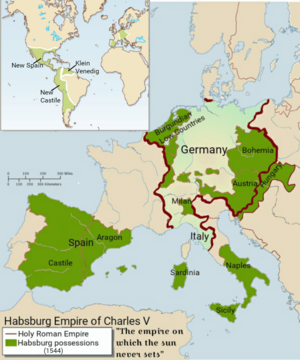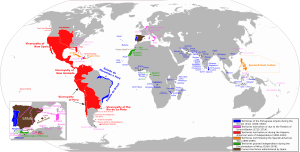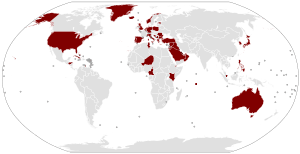The empire on which the sun never sets facts for kids
The phrase "the empire on which the sun never sets" describes a huge empire that was so big, it always had sunshine somewhere in its territory. Imagine the sun rising in one part of the empire while it was still daytime in another!
This idea of a global empire goes way back to ancient times with the Egyptians, Mesopotamians, Persians, and Romans. In more recent history, it was first used for the Habsburg Empire of Charles V. He was a powerful ruler who controlled many lands across Europe and the Americas.
Later, the phrase was used for the Spanish Empire, especially during the 16th, 17th, and 18th centuries, when it spread across the globe. Then, in the 19th and early 20th centuries, it became famous for describing the British Empire, which also covered a huge part of the world. More recently, people have sometimes used this phrase to talk about the worldwide influence of American power.
Contents
Ancient Empires and the Sun
The idea of an empire where the sun never sets is very old. Around 2300 BC, texts about Sargon of Akkad, a king from Mesopotamia, said he ruled "all the lands from sunrise to sunset." This meant his kingdom was vast.
Later, in ancient Egypt (around 1900 BC), a story called the Story of Sinuhe mentioned that the Egyptian king ruled "all what the sun encircles." This also showed the idea of a very large empire.
The famous Greek historian Herodotus wrote about the Persian King Xerxes I. Before invading Greece, Xerxes supposedly said that the Persian Empire would stretch "as far as God's heaven reaches." He added that "The sun will then shine on no land beyond our borders." This shows the Persians also had the idea of a huge empire.
The Roman Empire was also described in old Latin writings as stretching "from the rising to the setting sun." This means people thought of the Roman Empire as covering a vast area from east to west.
Charles V's Empire
Charles V was a very important ruler from the House of Habsburg. He controlled many different kingdoms and lands at the same time. His empire included the Holy Roman Empire, which stretched from Germany to Northern Italy. He also directly ruled the Low Countries (like modern-day Belgium and Netherlands) and Austria.
On top of that, Charles V was the King of Spain. Spain controlled kingdoms in southern Italy like Sicily and Naples. Most importantly, Spain had many colonies in the Americas. Some people say Charles V himself used the phrase "the empire on which the sun never sets" to describe his vast lands. Other sources say the poet Ludovico Ariosto or others used it first.
The Spanish Empire's Global Reach
Philip II of Spain, Charles V's son, made Spain the center of the huge empire he inherited. He set up important government councils in Madrid to manage different parts of his empire, including those in the Americas.
Philip II also added the Philippines to his colonial lands. These islands were even named after him! In 1581, Philip II also became King of Portugal, creating the Iberian Union. This meant he now ruled the Portuguese Empire as well. The Portuguese Empire had territories in the Americas, Africa, Asia, and many islands. With all these lands combined, the Spanish Empire truly stretched across the globe.
In 1585, an Italian writer named Giovanni Battista Guarini wrote about Philip II. He said that the sun "never sets" on the monarch's lands. Later, in the early 1600s, famous thinkers like Francis Bacon also wrote about how the sun never set on the Spanish Empire. They saw it as a great sign of glory.
Even in the late 1700s, the German writer Friedrich Schiller had Philip II say in a play, "The sun in my dominion never sets." This shows how well-known the phrase was for describing the Spanish Empire.
The British Empire's Vastness

During the 19th century, the phrase "the empire on which the sun never sets" became very popular for describing the British Empire. At this time, maps often showed British lands in red or pink, making it clear how much of the world they controlled.
In 1773, George Macartney wrote about "this vast empire on which the sun never sets." This was after Britain had won many new territories in the Seven Years' War.
In 1821, a newspaper called the Caledonian Mercury wrote about the British Empire. It said, "On her dominions the sun never sets." It explained that as the sun left Quebec City in the evening, it had already been shining for hours on Port Jackson (in Australia). And as it set over Lake Superior, it was rising over the Ganges River in India. This shows how the empire spanned different time zones around the world.
A famous American, Daniel Webster, also spoke about the British Empire in 1834. He described it as a power with "possessions and military posts" all over the globe. He said its "morning drumbeat, following the sun... circles the earth with one continuous and unbroken strain." This painted a picture of a constantly active, global empire.
By the mid-1800s, many British leaders and writers used the phrase to show pride in their empire's size and power.
American Power and the Sun
From the mid-1800s, the idea of the sun never setting also started to be used for Anglophone culture. This included both the British Empire and the United States. For example, in 1852, a speaker named Alexander Campbell said that God had given Britain and America the "new world." He added that "the sun never sets upon our religion, our language and our arts."
By the end of the 19th century, the phrase was sometimes used for the United States alone. An article in 1897 proudly stated, "the sun never sets on Uncle Sam" (meaning the USA).
In the 20th century, the idea of the sun never setting was often used in speeches about US foreign policy. It was used to show the worldwide reach of American power. For example, a history book from 1991 noted that "the sun never sets on American territory." This included properties owned by the US government and its citizens, US military forces abroad, and countries influenced by American power.
While this phrase often sounds patriotic, it is sometimes used to criticize American imperialism. For instance, a book by Joseph Gerson is titled The Sun Never Sets: Confronting the Network of Foreign U.S. Military Bases. This title suggests that the widespread US military presence around the world is a form of empire.
|
See also
 In Spanish: El imperio donde nunca se pone el sol para niños
In Spanish: El imperio donde nunca se pone el sol para niños
- King of Kings
- List of former transcontinental countries
- Nec pluribus impar
- Pluricontinentalism
- Plus ultra




